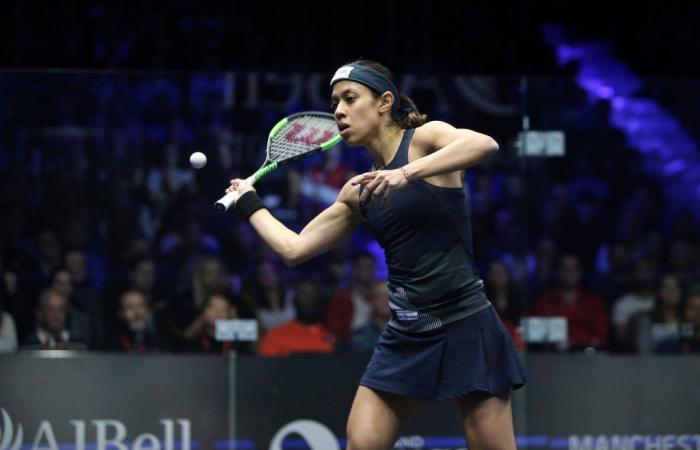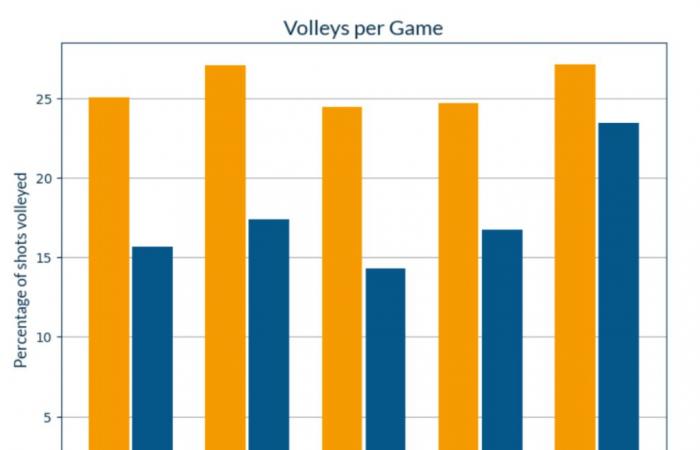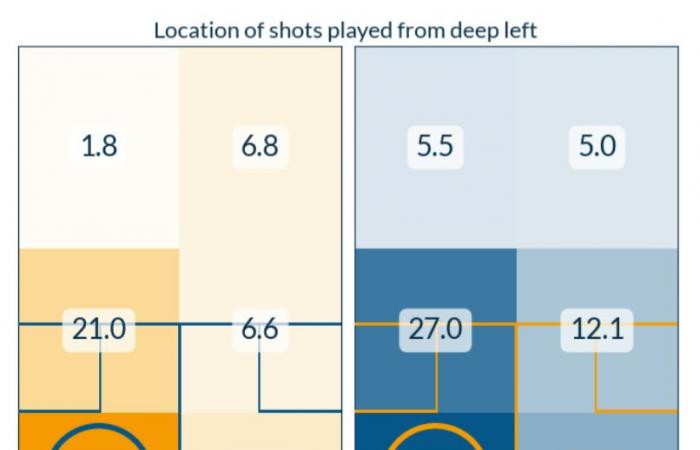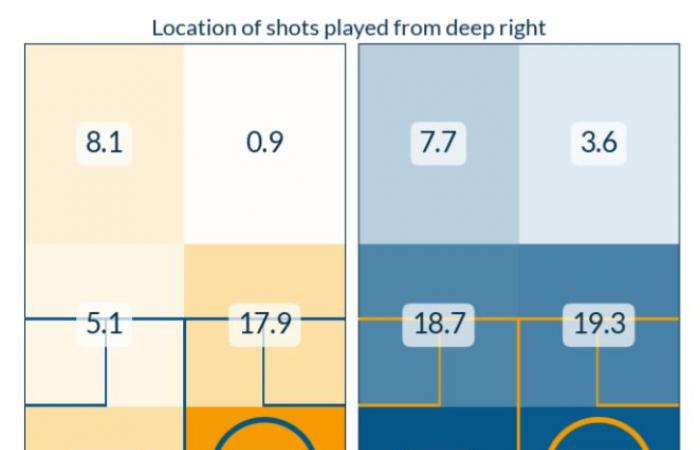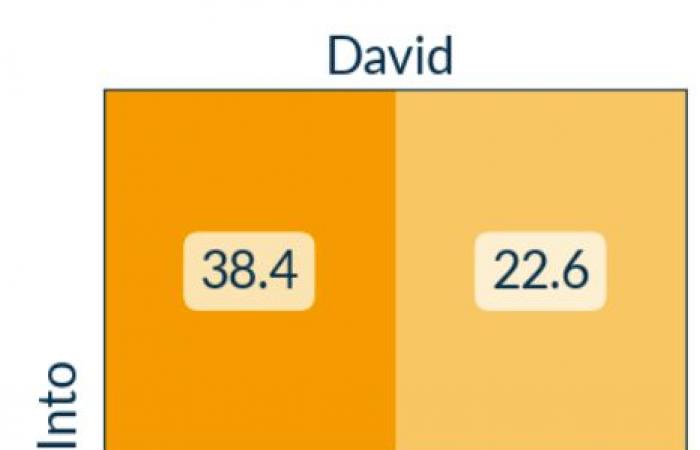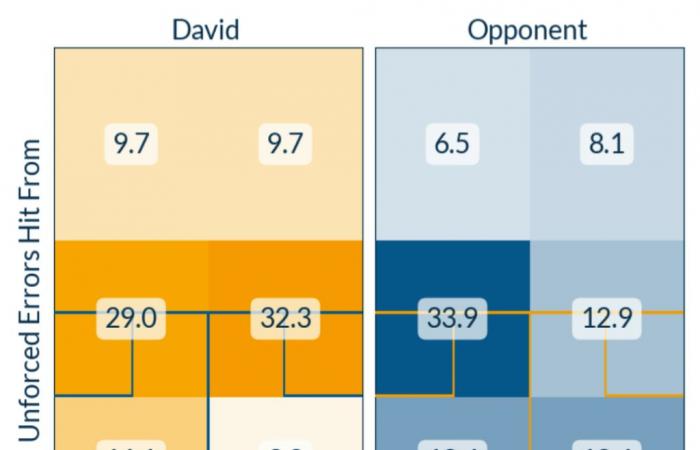For the first in the series of Past vs Present match-ups, squash data outfit Cross Court Analytics dug up the numbers to compare legend of the game Jansher Khan with current men’s World No.1 Ali Farag. While both men are two of the greatest movers the sport has seen, significant numerical differences emerged in their game plans, in shots volleyed, boasted, and lifted. In this piece, Cross Court delves back into the archive to put some numbers on the playing style of a more recent squash icon: Nicol David.
With 8 World Championships and 5 British Opens, Nicol David’s name is synonymous with the women’s tour in the first two decades of this millennium. In a glittering back catalogue, picking a handful of matches to revisit is no easy task – so who better to ask than David herself, who talked fans through her 5 most memorable encounters in her 19 year career.
David recollected three of her World Championship titles – amongst them her first in 2005 and her last in 2014 – and two of her latter-career defeats, including the final match she played on tour, against Nour El Tayeb in 2019. The Malaysian was known for her athleticism – her speed of movement and powers of endurance – and intensity of playing style, taking the ball early and punching purposefully to length to relentlessly drain the batteries of any challenger.
For the first time, thanks to data from Cross Court Analytics, we can now put numbers on David’s style of play. So, what do the stats say? And, a decade on since the Malaysian’s heyday, how do her numbers compare with the current women’s tour?
The place to start when analyzing intensity is the number of shots a player hits from mid-court. Hitting the ball ‘early’ – from across the short line, without waiting for the ball to drop deep – ensures your opponent has only limited time to recover from their shot and steady themselves for the next. David was a master at taking time away from opponents in this way: across the matches we’ve analyzed, David hit an extraordinary 44% of shots from mid-court. By way of contrast, her opponents in these matches mustered just 35% of their shots from the mid-court region. Put differently, opponents could expect to take the ball early against David once every three shots, while David was doing so just shy of one in two. David’s mid-court relentlessness was real.
[[ caption ]] David hit more shots from mid-court than her opponents at each stage of matches, from Game 1 through to Game 5.
Another metric which helps crystallize the notion of intensity is the number of volleys the player hits. Taking the ball on the full is another example of taking the ball early – letting the ball bounce will always give an opponent more time to set themselves. As you might expect, David dominated on the volley: across the matches analyzed, the 8-time World Champion took over 1 in 4 of her shots on the full, and limited her opponents to just 1 volley every 6 shots.
Those numbers tell us what proportion of a player’s own shots they are hitting on the volley, but another way to think about this volleying dominance is to ask ‘What percentage of the total volleys played in the match were hit by each player?’. In this framing, David hit 60% of total volleys played, with opponents making up the remaining 40% – an enormous difference at the top of the game.
[[ caption ]] David hit more shots on the volley than his opponents at each stage of matches, from Game 1 through to Game 5.
The flip side of the high-intensity coin is to force opponents to hit from deep – as the ball takes longer to travel from the front wall to this region of the court, you buy yourself more time to recover between shots. David excelled in this area too, making her opponents hit from deep on 55% of their shots – while she was forced to move deeper than the service boxes on just 45% of her shots. In relative terms, this is more than a 20% difference – a chasm, when the margins of professional play are so small.
In particular, David excelled at the fundamentals of returning shots from length to length. Zooming in on just shots played from the deep left region, David put her opponents back in this region for their next shot over 50% of the time; opponents did so to David only one shot in three. The contrast is even greater on the forehand: when hitting from the deep right, David again forced her opponents to hit their next shot from this region over half the time, while opponents did so to her on only one quarter of opportunities. None of these exchanges will make their way into a Shot of the Month compilation. But, when asked to play shots from traditionally defensive areas of the court, if you, like David, can leave your opponent in the same position more often than they do to you, you will be tipping the scales in your favor with every exchange.
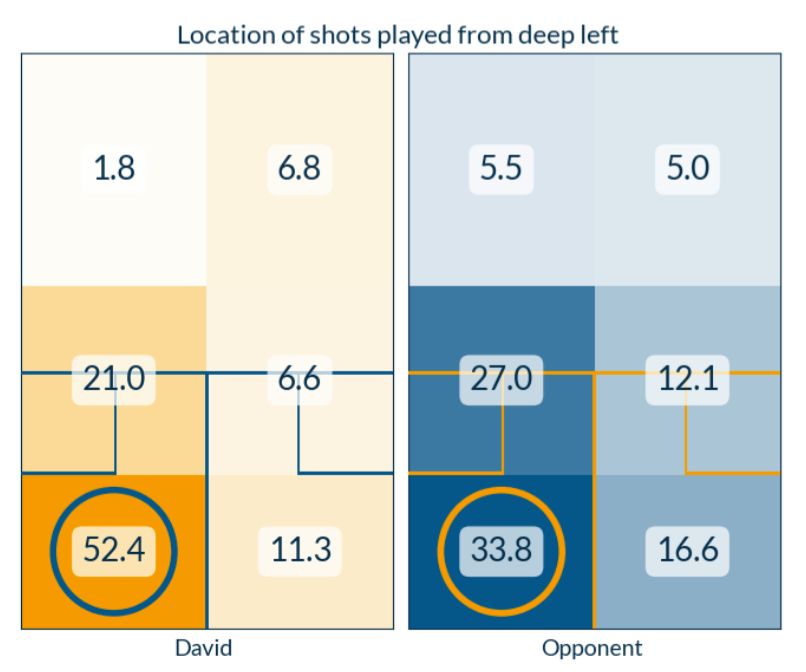
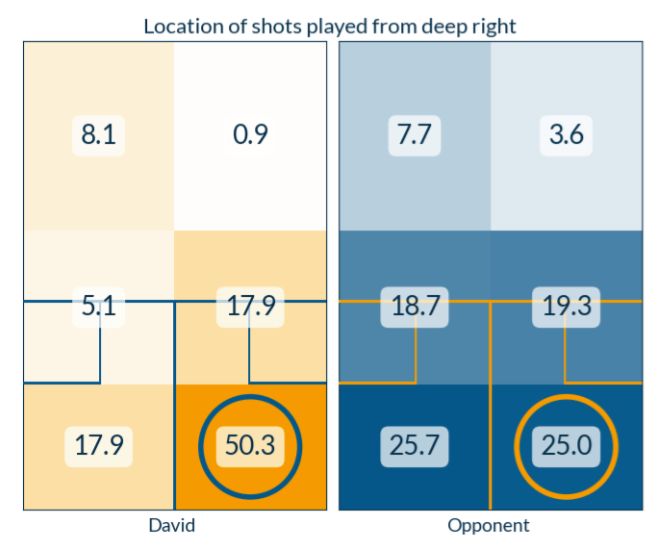
[[ caption ]] David’s game was underpinned by the ability to hit the ball from the deep corners back to the deep corners. These charts show where David and her dela Opponents hit the ball when hitting shots from the deep left and deep right regions (circled). The numbers are percentages of shots.
If playing the ball from mid-court and on the volley are the earliest points on the ‘playing with intensity’ spectrum, and if playing from deep puts you a notch further back on that spectrum, then the final point in the continuum is to play the ball when it’s rebounding off the back wall. Allowing the ball to come off the back wall before playing is the longest you can leave your shot. When opponents played David, they played 1 in 3 shots in this manner. David, however, was relentless in his intensity, allowing the ball to rebound less than 1 shot in every 5.
A tactic which often goes hand in hand with physical intensity is straight hitting: if you back yourself to outlast your opponent, you don’t want to offer them angles from which to attack. David was no exception to this tendency: the Malaysian hit cross court just 1 in 3 shots, with two thirds of her hitting going up and down the walls. Her opponents were more willing to change things up, however, with almost half of shots ‘opening up the court’ with cross courts.
We’ve put numbers on her rally patterns, but how did David tend to end points? Across these matches, the Malaysian hit 5.3 Winners per game on average – twice the frequency with which she hit Unforced Errors (2.6 per game). The backhand straight drop was David’s most prolific winning shot, accounting for around a third of the Winners she hit.
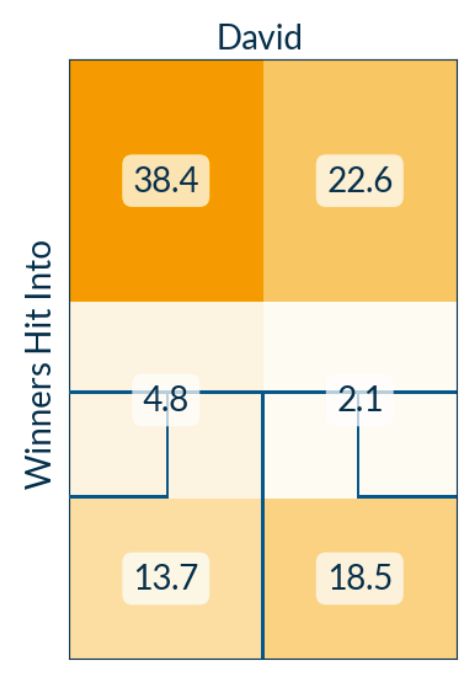
[[ caption ]] David hit her highest number of Winners into the front left region of the court. The numbers show the percentage of all of David’s Winners hit within each region.
But what is perhaps even more impressive was David’s Winner-to-Error ratio on this backhand drop – a useful indicator not of how often a player hits winners or errors, but rather informs us how efficient they were with that shot. After all, there is little point in frequently hitting drop shot winners if, in attempting to do so, you hit even more drop shot errors. And David certainly was efficient: for every Unforced Error that David made on the backhand drop, she hit an astonishing 6 winners this way.
Every champion knows their game plan – and David was no exception. She might only have hit 1 in 6 of her winners from deep (less than opponents who hit over 1 in 4 of their winners from here) – and she only hit 2% of her winners in this dataset from deep on her forehand. These numbers may feel underwhelming, but this is only half the story. David was not lethal from deep, but she also gave nothing away: she hits fewer than 20% of her Unforced Errors from deep, and only 3% of Unforced Errors from deep on her forehand. Her opponents? 40% of their Unforced Errors came from deep. As observed earlier, David’s ability to reset the rally to these regions time after time was enough to earn her the point without having to attempt risky winners.
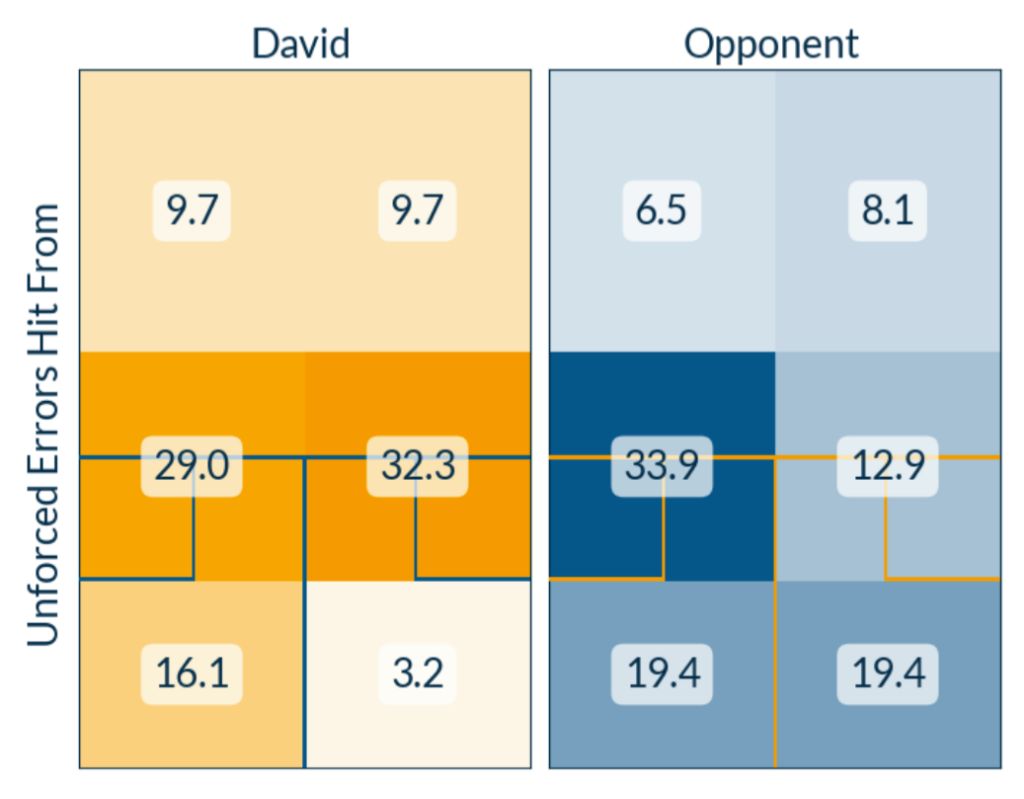
[[ caption ]] David hit few Unforced Errors from deep, consistent with a conservative playing style
How do David’s numbers compare to the 2024 tour?
One player whose gameplans resemble the Malaysian’s is Belgian World #4 Nele Gilis, currently enjoying her best season to date. Gilis, like David, is fleet of foot, can out-endure any challenger, and whose conservative playing style maximizes her physical attributes. Gilis looks to extend rallies where possible, and, like David, is lethal into the front left when given the opportunity. As with David, the Belgian’s most prolific winner is also the backhand dropand her efficiency resembles the Malaysian’s too: for every backhand drop shot tin, Gilis hits 5 backhand drop shot Winners.
Gilis also gets the ball deep well: like David, the Belgian makes her opponents hit on the rebound one shot in three, buying herself plenty of time to recapture the T. But one difference between Gilis and David here is how often Gilis herself hits on the rebound: while David did so on fewer than 1 in 5 shots, Gilis does so more than 1 in 4 – less than her opponents, to be sure, but more frequently than David.
This speaks to the biggest difference between the data we’ve collected on David and the data we’ve collected on Gilis: action areas. In David’s matches, 40% of all shots were struck from mid-court, with 50% of shots struck from behind the service boxes. In Gilis’ matches, less than 30% of the action takes place in the mid-court, while over 60% of shots occur from deep. The action in Gilis’ matches takes place further back on the court.
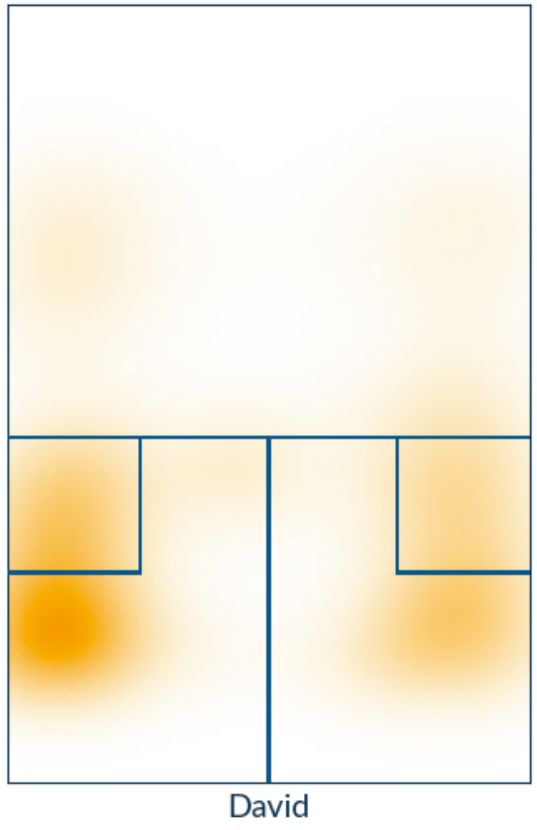
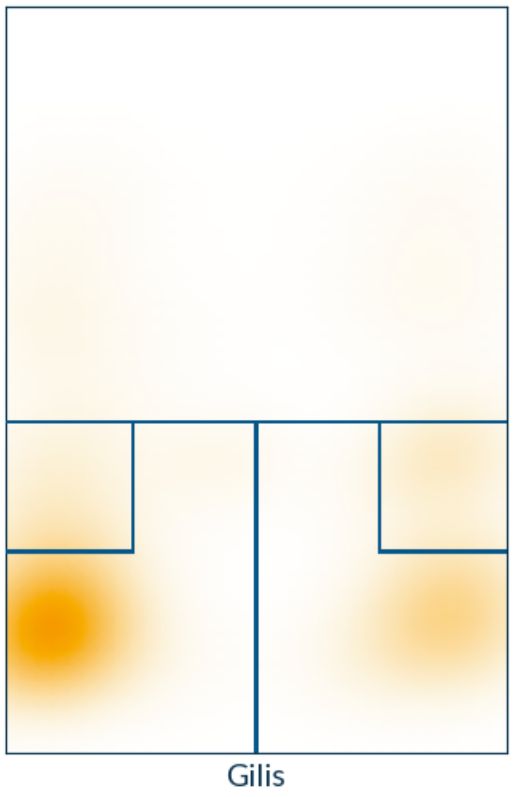
[[ caption ]] As shown in the Action Areas Heatmap, David was able to play more of her shots from mid-court than Gilis does.
One other change since David’s prime has been an increase in rally length: David could expect a typical rally in his matches to last 13 shots; the average rally length in Gilis’ matches is 17 shots. With these longer rallies comes a greater physical demand: while David covered on average 600 meters per game, Gilis’ court coverage is typically 775 meters – and this despite David beginning his career under the Hand-In-Hand-Out scoring system, which served up more rallies per game than the Point-A-Rally method now used.
There will always be individual exceptions – Ramy Ashour and Nour El Sherbini come to mind – but a good rule of thumb is that the longer the rallies and the deeper the action areas, the higher the standard of squash. If the David and Gilis numbers are reflective snapshots of the tour in general circa 2009 and 2024, then these stats also point to the quality of the tour in general having risen.
David dominated the tour in her pomp – remarkably, she occupied the #1 spot for a decade consecutively between 2006 and 2015. She won all 8 World Championship finals she reached. In Cairo in May this year, 7-time World Champion Nour El Sherbini has the chance to equal David’s record. Unlike David, El Sherbini’s numbers point to a player who values shorter rallies, who prefers groundstrokes to volleys, and who has no qualms attempting – and succeeding – in hitting winners from deep. It is one of our sport’s great attractions that players can approach the same 62 square meter stage in entirely different ways, and yet achieve equally impressive outcomes.
Nicol David’s 5 most memorable matches
Match 1: Nicol David vs Rachel Grinham, World Championship Final 2005
Match 2: Nicol David vs Natalie Grinham, World Championship Final 2006
Match 3: Nicol David vs Raneem El Welily, World Championship Final 2014
Match 4: Nicol David vs Annie Au, US Open 2017 https://www.squash.tv/replays/us-open-2017-round-2-7/
Match 5: Nicol David vs Nour El Tayeb, British Open 2019 https://www.squash.tv/replays/allam-british-open-2019-rd2-david-v-el-tayeb/
Tags: Nicol David Nele Gilis Cross Court Analytics Comparison
--
